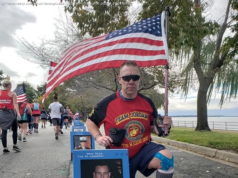 11:24 AM PST 2/3/2017
11:24 AM PST 2/3/2017
by
Stephen Galloway
Days after the death of David Shepard at age 76, his friends and colleagues paid tribute to the beloved silent film preservationist.
“I met him when I was 16 years old and he was 10 years older,” said movie historian and author Leonard Maltin. “We grew up in adjacent towns in New Jersey. I had started a motion picture club in my high school, and before our first conversation he offered to loan me a rare 16 mm print to show at out meeting. It was Busby Berkeley’s Roman Scandals [1933]. That started a friendship that lasted all these years.”
Shepard, he added, “really cared about movies, and silent films in a particular. He cared more about them than he did about his own ego. There are some people who want a lot of praise and attention for what they do; but he was more concerned with getting the films saved, preserved, rescued and shown — emphasis on shown. Like our mutual friend William K. Everson, the great film scholar, he believed that saving it and putting it on a shelf was not the point.”
Even when Shepard was living in the tiny community of Hat Creek, Calif., in recent years, he spread his love for the movies. “There was a very local film festival, and he became greatly involved,” said Maltin. “He had another place to win over converts to silent film.”
Shepard’s bete noire, said Maltin, was Raymond Rohauer, who operated a revival theater in Los Angeles and acquired the rights to some vintage libraries, but “was something of a notorious film pirate, who made unauthorized copies of films and then pounced on other [film] people even when they did something legal. As a joke, when David was at Blackhawk Films, he prepared a glorious version of Thomas Edison’s The Kiss — a primitive silent film [from 1896] that consists solely of a man kissing a woman, which runs seconds — and he plastered it with title cards saying ‘Property of Raymond Rohauer.’”
Alexander Payne, the director of Sideways and Election , recalled meeting Shepard when “he left USC for a while and taught one quarter at UCLA. I was in my first year of graduate school there and had been a film nut since I was a kid. I signed up for his class on the history of silent cinema and realized to my astonishment that this was the guy who had curated the Blackhawk Films collection, where all of my allowance money had gone as a kid. By the time I was 14, I had the Chaplin Mutuals and the Buster Keaton collection and Phantom of the Opera – and I still have them. But he would lend me prints, which I took home.”
Later, when Shepard was special projects officer at the Directors Guild of America, noted Payne, “Akira Kurosawa brought Ran there [for a screening], and David got me into an exclusive event to see John Huston introduce him.”
He remembered Shepard telling him about bumping into director George Stevens ( Giant ) when Shepard was working at the American Film Institute. “He was running some old Laurel and Hardy shorts that Stevens had directed. He said to Stevens, ‘They’re wonderful. I’d love to show them to you.’ Stevens said, ‘God no, I never want to see them again! All I’ll see is the property I didn’t buy.’”
Added Payne: “There’s this extraordinary memory palace that is film, and it was a work of supreme generosity for him to give to the human race those origins. He was able to express his love of man through his love and preservation of silent film. To my shame, he constantly invited me to Hat Creek, but I never made it, and now it’s too late. I am one of the many whose lives he touched.”
“David had an extensive film archive that he would dip into when teaching,” noted USC film school vice dean Michael Renov. “Our students had access to the highest quality and most complete versions of early films from around the world in 16 mm and 35 mm. These were the days before DVD versions of these classics existed. And it was he who produced many of the VHS and later DVD versions of silent film classics during the 1980s and 1990s that made so many great films available to the educational market, as well as to a larger public.”
Shepard, he said, “was a beloved teacher. His students — many of them production students focused on finding their way into the industry — developed a love for the aesthetic achievements of the silent cinema because of him. They found his enthusiasm for the cinema contagious. He will long be remembered by those students and by his USC colleagues.”
USC film school dean Elizabeth Daley recalled another professor, Richard Jewell, telling her that “whenever there was a school event, David brought his homemade hot fudge and ice cream in his own pot. Every student and faculty [member] lined up for it. So he furnished both film and food for many years at USC.”
She added: “We are deeply saddened to hear of David’s death. He taught at USC Cinematic Arts for many years and instilled a love for early film in generations of students. His death is a profound loss to all who treasure the art form.”
Shepard, most recently the head of Film Preservation Associates, died January 31 after a battle with cancer. A man of exceptional gentleness and warmth, he was a friend of such eminent directors as King Vidor, and also counseled a generation of contemporary filmmakers, including Payne.
Payne read a letter from Shepard accepting an award from the Los Angeles film critics last year.
“I fell in love with silent film and its possibilities as a teen in the basement theater of a Broadway and radio actor named John Griggs,” the letter stated. “He played piano for silent films as a teen in his hometown of Glen Ellyn, Illinois, and began collecting original prints of silent movies when they were widely available in the 1930s and ’40s. Mr. Griggs screened films from his collection on Sunday afternoons, where the other regulars included a 13-year-old, your fellow member Leonard Maltin.”
He added: “Perhaps you know that less than 20 percent of silent cinema survives today in even a single copy. No other art form has suffered greater neglect or more deliberate destruction. Beginning in 1968, when I started hunting film for the Library of Congress, I realized that more great work of our film pioneers would last into the future because I brought it in for archival preservation. That’s how I became interested in popularizing it. In the trajectory from 16 mm and 8 mm film to VHS, laserdisc, DVD, Blu-Ray and streaming, one great reward in my work has been hearing regularly from kids who discover easily-accessible silent film, despite residing far from archives and museum theaters in unlikely places such as Omaha, where young Alexander Payne took his first steps in film. Many of these kids can’t interest their friends in early film but I’m easy to find, so if they have been good all week, their parents allow them to call me and talk old movies.”
Shepard began his career in 1968 at the AFI. Later, he joined Blackhawk, which distributed film classics in 8mm and 16mm. When Blackhawk closed, in 1987 Shepard obtained its restoration technology and film catalog, which included films by D. W. Griffith and Chaplin. More recently, his Film Preservation Associates worked with such companies as Kino Lorber, Flicker Alley and Lobster Films not only to restore movies but also ensure their dissemination.
Домой
United States
USA — Art Alexander Payne, Leonard Maltin Pay Tribute to Late Film Preservationist David Shepard






